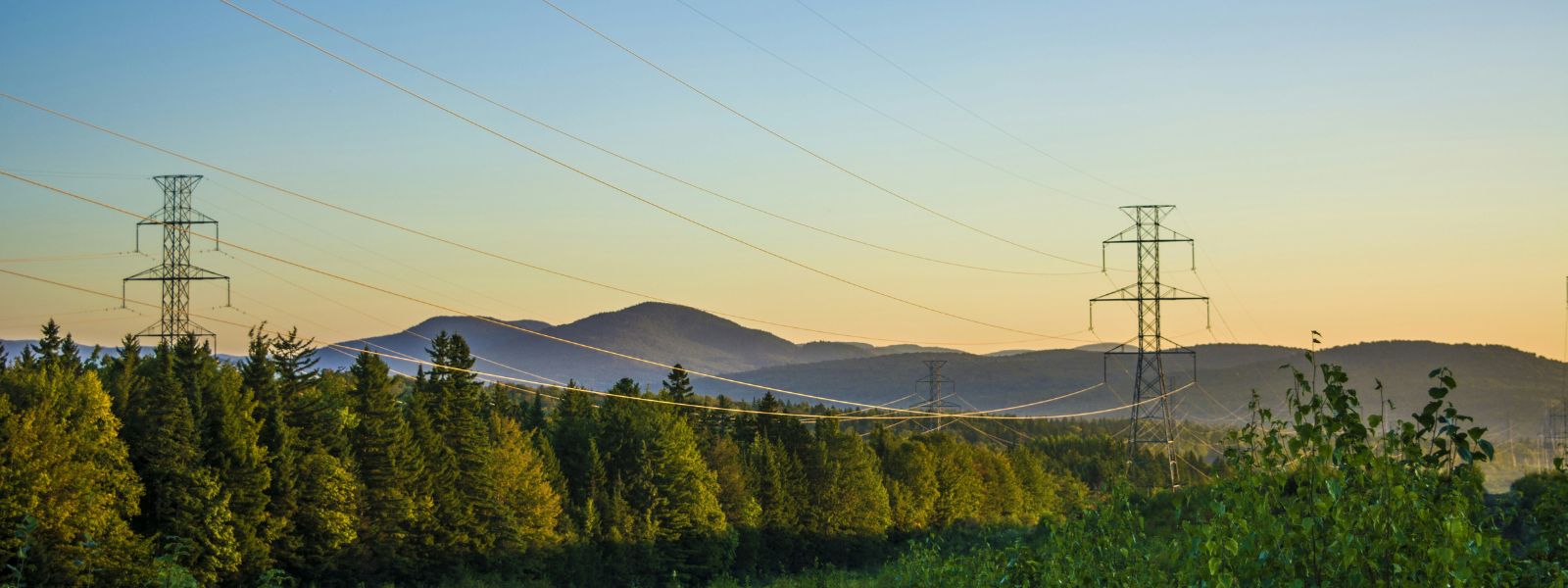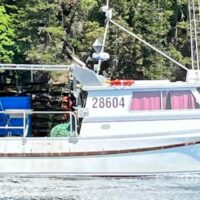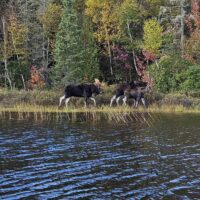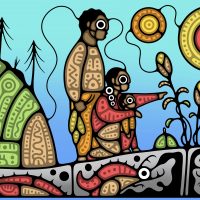
The authors dedicate this paper to the late Byron LeClair. His efforts made this work possible.
Introduction
In uncertain times, one thing is clear: Canada’s Indigenous communities will play a pivotal role in the evolving clean energy transition. A recent Canadian Climate Institute piece shows that this process of sustainability-rooted economic reconciliation is well underway; the last few decades have seen a surge in Indigenous clean energy generation projects. But times are changing, and Indigenous entities are now playing important roles in other aspects of the energy transition beyond generation hallmarks like solar, run-of-river hydroelectricity, and wind. That necessary evolution includes the commissioning of new transmission infrastructure. The excerpt below from the above mentioned 2022 Canadian Climate Institute Waves of Change Report confirms the emerging Indigenization of transmission, and that this increase in Indigenous electricity transmission participation is not some abstract, theoretical, or wishfully normative future:
The 2015–2020 period also saw a significant rise in Indigenous participation in electricity transmission projects. A total of 19 such projects are now completed or in construction, including some linked to grid access for major projects (e.g., La Romaine Hydro, Quebec), off-grid community interconnection (e.g., Wataynikaneyap Power, Ontario), and grid strengthening (e.g., Bipole III, Manitoba).
Notably, Indigenous organizations are participating in these capital-intensive sectors as leaders and majority owners. In this new participatory environment, additional community-rooted, policymaker-focused commentary is necessary. There are legal, social, economic, and (of special relevance here, given the fora) environmental benefits associated with Indigenous inclusion in new transmission lines. It is essential that Canadian policy leaders carefully consider these benefits when determining the best way to allocate scarce time and money towards Indigenous economic reconciliation and climate change mitigation—two defining challenges for Canada in the 21st century.
[Click here to see the English version] Ōma nīhithaw kakīskīkīmowin-masinahikan ikīmasinahikātīk, kawīcihikocik omistikōsiwak, aniki kātoskātākwāw pithīsīskotīw, ka-kiskīthītākwāw īsi nīhithawak ka-mitho-wītatoskīmīcik, īsi nīhithawak kā-isi-nistōtākwāw ōmītowak atoskīwin.
With these trends in mind, the following Indigenous Perspective is oriented towards maintaining momentum around Indigenous participation in transmission infrastructure – with an eye to pragmatic options that might accelerate existing progress.
We see our work as partially addressing an imbalance in the energy transition literature towards Indigenous engagement in clean electricity generation. This historical (over)emphasis, while laudable and understandable, needs to now expand to include transmission (as well as other relevant topics spanning the electricity value chain, such as electricity distribution). Extensive research highlights that Indigenous leadership and participation is possible across multiple dimensions of the complex energy transition (see here for our most recent work on this topic, and here for past work on novel Indigenous transmission ideas). We emphasize in this piece concrete and realistic conceptual foundations for policymakers keen to advance Indigenous-inclusive electricity projects that broadly benefit Canadians.
Who we are
Led by Frank Busch, the first ‘treaty status’ CEO of a Canadian Tier 1 publicly traded company, this perspective integrates an Indigenous viewpoint rooted in, and corroborated by, the thoughts and experiences of the collaborating authors. We open this section by emphasizing the following: this Indigenous perspective is an informed, but highly person(s)-specific perspective rooted in Indigenous community energy and economic development practices. Moreover, it is not the defining perspective for every community. In fact, it is not even to be taken as the collective perspective of Busch’s home of Nisichawayasihk (Nee-chise-away-a-see) Cree Nation. Instead, it is our hope this work contributes to a budding Indigenous-led dialogue around the non-generation aspects of clean energy transformation.
As a team of both Indigenous and non-Indigenous authors, we seek to provide what our practitioner and academic experiences suggest are select best practices for communities navigating what their participation in Canada’s transmission future will ultimately entail. Our recommendations are conscious of select theory and extant literature while remaining anchored in practice (with a special grounding in both the lived experiences and direct observations of the lead author).
As just some examples of the background on which we will be drawing, Busch has visited over 300 Indigenous communities over the last two decades, while others members of the authorship team have lived in remote communities (Krupa) or supported Indigenous-led environmental assessments in Western Canada (Hanna – see Nishima-Miller et al.). This work synthesizes these decades of energy transition and community development experience and is, in turn, supplemented by literature-based and/or real-world examples spanning early-stage feasibility testing to long-term operations.
Why transmission matters—and why Indigenous ownership is a rare triple win in energy markets
The implementation of the United Nations Declaration on the Rights of Indigenous Peoples (UNDRIP), which Canada has signed, mandates that all electricity transmission projects planned for Canada’s goal of achieving net zero emissions by 2050 must involve Indigenous consultation, equity participation, and/or construction participation. Even in 2025, many Indigenous communities remain reliant on expensive, often unreliable, and occasionally dangerous diesel-generated electricity that inhibits Nation-led efforts to expand local economies and provide better opportunities for young people. This status quo, which stems at least in part from transmission gaps, culminates in what van de Biezenbos calls Canada’s energy persistent poverty. As van de Biezenbos points out, this not only creates unacceptable energy injustice, but also stifles much-needed economic growth. Energy persistent poverty is unlikely to change without new thinking around transmission projects in particular.
Beyond the sound sociolegal basis for new transmission efforts outlined thus far, the climate-related motivation for increasing analysis on Indigenous-friendly electricity transmission projects is similarly clear. This could be executed under a wide array of scenarios: expansions of existing planned or mid-term intraprovincial lines, ties facilitating greater interprovincial electricity trade, additional lines connecting Canada to the United States, or even (more theoretical) long-distance intraprovincial connections between sparsely populated, but clean electricity-rich, regions and the industrial heartlands or urban areas where extra electricity supply is needed. The clean energy transition is commonly envisioned as an exercise in commissioning much greater levels of wind, solar, and hydroelectricity resources. However, without adequate transmission interconnections, renewable energy generation outputs (many of which are situated in distant places full of excellent wind resources or sunny skies) have nowhere to go. Although underappreciated, transmission is the anchor for realizing lofty climate change ambitions.
Canadian research shows systemic cost efficiencies and emission abatement potential associated with transmission expansion and interconnection, such as better value extraction from existing clean energy assets and enhancing the value of carbon pricing policies. As elucidated in the important paper The cost of decarbonizing the Canadian electricity system, transmission also offers one of the lowest cost emission reduction options for Canadians.
[Click here to see the English version] ōma pithīsīskotīw atoskīwin ōta ministik kānata kwayask mistahi atoskīwin, mistahi mīna ikota oci kakī-sōniyākipathiw māka, poko nīhithawak kawītatoskīmīcik.
Put simply, unlocking Canada’s renewable electricity potential requires significant investment in transmission, and transmission can only proceed with Indigenous inclusion.
Of course, achieving optimal outcomes is easier said than done. The reality is that constructing transmission lines is lengthy and arduous work. Power transmission involves enormous capital outlays, the ability to marshal and organize a diverse team of professionals (legal, technical, and others) over multi-year or even decadal time frames, and the capacity to overcome a remarkable array of different obstacles. Of concern, the historical record of enhanced transmission integration (such as in Busch’s home province of Manitoba) suggests that ultimate environmental outcomes are not uniformly beneficial. While such constraints and downsides are well beyond the scope of this short case study, we wanted to ensure they are acknowledged upfront as we move towards concrete starting points for policymakers in particular to consider.
Pragmatic next steps for policymakers to support Indigenous-centric transmission integration
Many Indigenous communities are seeking greater opportunities to develop local, sustainable, and environmentally-sound economies, as well as increase access to employment opportunities for community members via revenue-bearing assets that can improve a nation’s financial standing. The following constitute five specific recommendations, all of which overlap with the much lengthier series of recommendations provided in the recent First Nations Major Project Coalition’s National Indigenous Electrification Strategy. We offer the following recommendations as starting points for Indigenous-linked policymakers to consider as possible ways forward in achieving greater economic and political sovereignty for their energy futures.
Piyak-kakīskīkīmowin: kāpacītāniwaki ōki “5 Cs” masinahikan
Recommendation 1: Implement the ‘5 Cs’ framework
In the 2012 paper Identifying barriers to Aboriginal renewable energy deployment in Canada, Krupa outlined the fundamentals to a successful Indigenous renewable energy deployment framework. It was noted at that time that it is critical to focus on three ‘Cs’—cash (capital), clarity (specifically regulatory and policy), and capacity (particularly within communities and on-reserve). Increasing access to capital remains the overarching priority for Indigenous communities looking for opportunities in renewable energy, as does improving regulatory and policy clarity for community leadership. There also remains a need to build in-community capacity across a range of domains (human, as already noted, but also technical, financial, and otherwise).
Over the last decade, we have expanded the ‘3 Cs’ framework to include corruption-less and community champions to form the ‘5 Cs’. The first is self-explanatory, while the second calls for ongoing innovation within communities to ensure the effective seeding and nurturing of community visionaries capable of enacting difficult long-term planning.
Such concepts are rooted in Busch’s on-the-ground experience, as well as Krupa’s multiple years spent working for, and living in, Biigtigong Nishnaabeg (formerly the Ojibways of the Pic River First Nation), one of the earliest pioneers in the Indigenous clean energy space. This journey, chronicled in Blazing a new path forward: A case study on the renewable energy initiatives of the Pic River First Nation, made clear time and again the remarkable benefits of leadership from that community’s champion: the late Byron LeClair. (LeClair’s role, specifically, is affirmed in foundational texts like Henderson’s Aboriginal Power: Clean Energy and the Future of Canada’s First Peoples). Leclair’s tenacity and dedication played an outsized role in an eventual clean energy portfolio that included, among other achievements, one of the nation’s first wholly Indigenous-owned run-of-river hydroelectric sites.
[Click here to see the English version] Aniki nīhithaw-itāwina āsay kā-sōki-atoskāsocik, iyakwani mwāci kāmithokāpawicik ispihk ōma pithīsīskotīw-atoskīwin pikiskwācikātīki, iyakwani nīkān kakī-pīkiskwātīcik.
High capacity communities with knowledgeable and competent champions at the helm are the most critical catalyzers for Indigenous electricity transmission projects.
Nīso-kakīskīkīmowin: kanistawinikātīk nīhithaw kiskinwāhamākīwina, nīhithaw itāwina anohc kā-isi-pimipathītāniwaki, mīna īsi ōma pithīsīskotīw-atoskīwin kātī-isi-wathasowācikātīk.
Recommendation 2: Acknowledge the alignment between Indigenous values, contemporary Indigenous communities, and electricity transmission planning
We should be skeptical of attempts to present a homogenous ‘Indigenous’ voice across the array of voices that must define all 21st century attempts to engage with Indigenous Peoples. Nevertheless, it is fair to say there are at least two common themes that tend to unite Indigenous communities:
- There is a desire to preserve environmental integrity, which may manifest at a variety of different levels (e.g. global, regional or territorial).
- Indigenous communities are bonded to the land in numerous ways: physically, emotionally, spiritually. Paired with this stability is the relatively low likelihood of substantial immigration inflows to many Indigenous communities—particularly in the remote areas who may be positively impacted by transmission projects.
Put another way, the characteristics of electricity transmission projects (notably their long time span, minimal impact on land compared to other infrastructure projects, and ability to facilitate more renewable and clean technology integration) align with general Indigenous values: protecting the land and living in close, respectful relation to it. Other transmission line characteristics (such as their job creation potential and physical presence in remote areas) align with modern day Indigenous community characteristics.
As a result, it is worth noting that decarbonization-friendly transmission is likely to be preferred by communities versus fossil fuel alternatives, except in the case where no other attractive alternatives are available. In the case of the proposed Ksi Lisims floating liquefied natural gas (LNG) facility that is spearheaded by the Nisga’a Nation, Waters shows tensions exist between Indigenous groups over LNG development. Clearly, it is difficult to ask communities to forego economic empowerment for the sake of system-wide environmental benefits. Recognizing the presence of this tension and balance—and working hard to offer compelling environmentally beneficial alternatives to more environmentally impactful projects—is a key area for policymakers to focus on.
[Click here to see the English version] Owathasowītinowak poko kamiskawācik aniki nīhithawak kā-nōtī-wītatoskīmīcik, aniki nīhithawak pimiy-atoskīwin kā-nōtī-atoskātākwāw- ōma transmission-atoskīwin kākī-māci-atoskācikātīw.
Policymakers need to work to find attractive alternative options for Nations considering fossil fuel development—starting with transmission.
Nisto-Kakīskīkīmowin: manācītāk nīhithaw kiskīthītamowin, kistīthīta īsi kēhtē-ayak kā-isi-kiskīthītākwāw.
Recommendation 3: Prioritize the perspectives of Indigenous knowledge keepers and Elders
The indispensable role of knowledge keepers and Elders in guiding a major community milestone like transmission participation can be easy to overlook in the excitement of pursuing a new project. This is a process that can be hands-on, with the flexibility to incorporate it into any stage of the project lifecycle, including the very early stages. The tangible financial benefits that such an approach might deliver should not be underestimated. For example, long-time proponents (themselves Indigenous) from Five Nations Energy in northern Ontario focused on involving Elders in scoping the ultimate project route from transmission lines through geomorphologically-complex terrain.
Busch has seen first hand the development of a novel participatory process in the construction of the Wuskwatim Generating Station, a $1.3 billion 200 megawatt hydro dam, and an accompanying $300 million transmission line built in partnership between the Nisichawayasihk Cree Nation and Manitoba Hydro. In the development of the project, recognized Elders were hired on as community consultants and assisted in site selection, ingress/egress, and community engagement alongside engineers and other professionals. While experts were skeptical at first, it soon became apparent that synergies were occurring based on the community consultants’ knowledge of the land and local residents, combined with sound scientific practices and engineering.
In addition to these meaningful technical contributions, there were social license benefits as well. Manitoba Hydro staff knew that they were walking into a hostile environment, as many community members harboured anger and resentment towards the provincial power utility due to the Churchill River Diversion project in the early 1970s. Without the community consultants to make introductions, it is likely many community members would have avoided meaningfully engaging with Manitoba Hydro (or even opted to forego engagement altogether). Through careful community dialogue and supportive public education, the citizens of Nisichawayasihk Cree Nation began to see the project as an economic and educational opportunity. The project was eventually successfully completed in 2006, creating a new pathway for future hydroelectric projects in Manitoba (including the $8.7 billion 695 megawatt Keeyask Project, completed in May 2022).
[Click here to see the English version] Owathasowītino-masinahikīwak, nawac kakī-pimicisāhakwāw nīhithaw kiskīthītamowin ispihk kākithaw ōma pithīsīskotīw-atoskīwin atoskācikātīki -ispihk mīna transmission-atoskīwin atoskācikātīki.
Policymakers should better incorporate knowledge keeper knowledge in every stage of the clean technology value chain—including transmission.
Nīyo-kakīskīkīmowin: kinawāpāta kākithaw atoskīwina kāmitho-kīsītāniwaki ōta ministik-kānata mīna opimī
Recommendation 4: Look at what successful projects have done both in Canada and beyond
Instructive examples of successful projects do exist. The first and most obvious departure point is for communities to strategically capitalize on opportunities via consortium partnership models that involve multiple communities, while also delivering clear value to other stakeholders groups such as ratepayers or environmental advocates. It’s the “we can go further together” principle. And it can happen!
A factsheet from the major investor-owned utility NextEra Energy demonstrates several core principles for this sort of success in a brief case study on Northern Ontario’s East-West Tie along the north shore of Lake Superior. First, at a very basic level, the East-West Tie’s 450-kilometre line—described as “one of the largest investments in the electricity system in Northwestern Ontario in decades”—facilitated the ongoing expansion of capacity (including clean electricity asset investments) to the region. This could include projects such as solar, wind, and run-of-river hydro, as well as potential decarbonization opportunities for the future, such as the novel Chigamiwinigum Falls project located within both Pukaskwa National Park and the Biigtigong Nishnaabeg’s traditional territory. This $777-million project worked to involve myriad Indigenous and non-Indigenous communities along the line, with Indigenous communities given the ability to participate in terms of both equity and jobs from construction and operations. Finally, this competitively procured line offered excellent reliability and flexibility benefits for ratepayers, while also unlocking new industrial sector opportunities.
A second example from the U.S. is also worth highlighting: new tribal financing pioneered through Biden-era flagship clean energy legislation. The Biden Administration’s Greenhouse Gas Reduction Fund and Loans Program Office provided capacity building and technical assistance, as well as resources on financing tribal energy projects—ranging from support for the inclusion of commercial lenders to incorporating de-risking tools like loan guarantees across a wide range of projects.
Closer to home, projects such as the Wataynikaneyap (or “Watay”) transmission line not only helped electrify communities along its corridor, but also supported environmental betterment via reduced diesel usage and potential for enhanced renewable energies integration and general economic growth, which may include critical mineral extraction opportunities that can support decarbonization technologies. This is only a handful of ideas; there’s an abundance of lessons learned now available. Future proponents would do well to do their homework.
[Click here to see the English version] Owathasowītino-masinahikīwak poko kakinawāpātākwāw aniki atoskīwina kākī-mitho-kīsītāniwaki, mīna ispihk kāti-māci-wathasowācikātīki nīhithaw-kiskinōtawi-masinahikana, kamamitonīthīcikātīki aniki āsay kākī-mitho-atoskācikātīki -mīna, aniki kīkwāya namwāc kākī-mithopathiki atoskīwina.
Policymakers need to build off past successes, and when structuring frameworks for Indigenous participation, be mindful of what has worked—and, perhaps even more importantly, what has not worked.
Niyānan kakīskīmowin: kākiskīthīcikātīk, kākithaw nīhithawak pītos isi-atoskīwak.
Recommendation 5: Avoid prescriptive participation—Tailor methods to fit the setting
Raising finance at the scale needed for involvement in transmission can be daunting, though it’s clearly possible. In our home province of British Columbia (B.C.), $36 billion in planned transmission and distribution projects through BC Hydro could entail important opportunities for Indigenous proponents, and would build upon the approximately $3 billion in Indigenous clean energy project ownership announced in December 2024 by the B.C. Government.
This means that communities must remain flexible regarding how benefits from a transmission project ultimately take shape. These benefits might include construction jobs, either at the outset or throughout the project’s lifespan, or equity opportunities, allowing communities to hold a significant ownership stake, depending on available human and financial capital. Hydro One’s pledge to enable 50 per cent equity ownership for Indigenous nations in new Ontario transmission lines is one example that could reduce risk for Indigenous partners, industry, and lenders alike. Regardless of the final arrangement, transmission projects can offer a broad range of employment opportunities—from professional roles, such as project managers overseeing multi-year builds, to skilled trades and polytechnical positions like lineworkers maintaining reliable operations.
Participatory agnosticism also extends to the scale of the project pursued. For example, some communities may be keen to realize energy interconnection, others to support energy sovereignty, and yet others to access economic gain. But all must be pragmatic about the financeability of the project. Is there policy and regulatory clarity, ideally supported by policy de-risking tools such as loan guarantees? Could a deep-pocketed co-proponent provide financing, or are there other creative financing options, such as syndication, private capital, or others, available? Are there credible internal and/or external experts available to secure the best terms, optimize the accounting, and spearhead responsible corporate governance? Honest, frank conversations need to be had in deciding how best to facilitate Indigenous involvement.
[Click here to see the English version] Namōtha kākithaw nīhithawak kakī-isi-pamiyāwak. Kisowāk kakī-wītatoskīmīcik nīhithawak. Īta kākaskītāniwak, kamitho-sītoskācik nīhithawak, nawac kamitho-wīcihisocik.
Policymakers need to avoid homogenous solutions to heterogeneous communities, and, where possible, close gaps in capacity to ensure a level playing field.
Final thoughts
We would be remiss not to repeat our earlier point that, like all infrastructure, electricity transmission has its impacts. These impacts can be physical, substantially altering the landscape (the impacts of Manitoba Hydro projects on Indigenous communities is particularly instructive in this regard). They can also be social or emotional, shaping and changing the way a community interacts with their traditional territory. Policymakers should do whatever possible to ensure new projects are built with economic, social, and environmental considerations (not necessarily in that order) in mind.
Yet despite these issues, we remain optimistic and hopeful about the future of Indigenous-inclusive transmission projects in Canada. As emphasized earlier, we have developed this short perspective as a team of Indigenous and non-Indigenous practitioners and scholars. Indigenous communities across Canada could facilitate the development of the transmission infrastructure backbone for a clean energy revolution, and in 2025 and beyond, unpacking the nexus of Indigeneity and transmission expansion is a critical decarbonization research priority. Including Indigenous voices and perspectives will be central to both the global and Canadian energy transitions.
This is not a simple question of altruism; it is a legal reality. Nor is it a question of seeking out enthusiasm. Indigenous people have seen the success of certain hydroelectric and transmission groups in action, such as the late Chief Billy Diamond’s work in Quebec (as outlined by MacGregor’s 1989 book Chief), and are acutely aware that much more needs to happen much faster. We emphasize the somewhat atypical economic-social-environmental “win-win-win” nature of Indigenous clean energy market participation via transmission expansion. It is essential that Indigenous perspectives become part of foundational planning for energy transmission across Canada; without such collaboration and partnerships it will be difficult to create the energy prosperity and opportunities Canada needs.
Acknowledgments
The authors thank Naoko Ellis, Derek Gladwin, Maria Shallard, Jessie Sitnick, Jason Dion, Grace Donnelly, & Avery Valez for their comments and ideas, especially in the early stages of drafting this piece. The authors take full responsibility for any and all errors in this piece. Krupa’s work was supported by Mitacs through the Mitacs Accelerate program. Krupa also acknowledges support from Accelerating Community Energy Transformation, through the Canada First Research Excellence Fund. The funding sources had no role in any aspect of writing this piece. All the views expressed, and all errors, remain the responsibility of the authors. Busch, Krupa, and Hanna further affirm that all views expressed herein represent the perspectives of the authors, and are therefore not to be taken as representative of the views of any organization(s) with which they were/are affiliated in the past, present, and/or future. Finally, Krupa and Busch would like to especially thank Adita Ortega Perez and Angie Busch, who provided a great deal of support in making sure this Indigenous Perspective crossed the finish line.
References
Bennett, N. (2024, December 2). B.C. First Nations want in on power transmission development. Business in Vancouver. https://www.biv.com/news/resources-agriculture/bc-first-nations-want-in-on-power-transmission-development-9896205
Canadian Climate Institute. (2022). Waves of change: Indigenous clean energy leadership for Canada’s clean, electric future. Retrieved from https://climateinstitute.ca/wp-content/uploads/2022/02/ICE-report-ENGLISH-FINAL.pdf
CBC News. (2014, July 16). Pic River First Nation plans hydroelectric plant in national park. CBC News. https://www.cbc.ca/news/canada/thunder-bay/pic-river-first-nation-plans-hydroelectric-plant-in-national-park-1.2710039
Dolter, B., Fellows, G. K., & Rivers, N. (2022). The cost effectiveness of new reservoir hydroelectricity: British Columbia’s Site C project. Energy Policy, 169, 113161. https://doi.org/10.1016/j.enpol.2022.113161
Dolter, B., & Rivers, N. (2018). The cost of decarbonizing the Canadian electricity system. Energy Policy, 113, 135-148. https://doi.org/10.1016/j.enpol.2017.10.040
English, J., Niet, T., Lyseng, B., Palmer-Wilson, K., Keller, V., Moazzen, I., Pitt, L., Wild, P., & Rowe, A. (2017). Impact of electrical intertie capacity on carbon policy effectiveness. Energy Policy, 101, 571-581. https://doi.org/10.1016/j.enpol.2016.10.026
First Nations Major Projects Coalition. (2024, April 22). National Indigenous Electrification Strategy [PDF]. https://fnmpc.ca/wp-content/uploads/FNMPC_National_Electrification_digital_final_04222024.pdf
Gale, S., & Gladu, J. P. (2024, October 2). Indigenous nations are key to powering Ontario. National Observer. https://www.nationalobserver.com/2024/10/02/opinion/indigenous-nations-are-key-powering-ontario
Government of British Columbia. (2024, December 9). New wind projects will boost B.C.’s affordable clean-energy supply [News release]. https://news.gov.bc.ca/releases/2024ECS0048-001643
Government of Canada. (2024, November 26). United Nations Declaration on the rights of Indigenous Peoples Act. https://laws-lois.justice.gc.ca/eng/acts/u-2.2/page-1.html
Harvey, L. D. D. (2013). The potential of wind energy to largely displace existing Canadian fossil fuel and nuclear electricity generation. Energy, 50, 93-102. https://doi.org/10.1016/j.energy.2012.12.008
Henderson, C. (2013). Aboriginal power: Clean energy and the future of Canada’s First Peoples. Rainforest Editions.
Hydro One. (n.d.). Indigenous relations. Retrieved April 15, 2025, from https://www.hydroone.com/about/indigenous-relations
Keeyask Hydropower Limited Partnership. (n.d.). The project. https://keeyask.com/the-project/
Krupa, J. (2012a). Blazing a new path forward: A case study on the renewable energy initiatives of the pic river first nation. Environmental Development, 3, 109-122. https://doi.org/10.1016/j.envdev.2012.05.003
Krupa, J. (2012b). Identifying barriers to aboriginal renewable energy deployment in Canada. Energy Policy, 42(1), 710-714. https://doi.org/10.1016/j.enpol.2011.12.051
Krupa, J. (2013). Realizing truly sustainable development: A proposal to expand aboriginal ‘price adders’ beyond Ontario electricity generation projects. Utilities Policy, 26, 85-87. https://doi.org/10.1016/j.jup.2012.07.008
Krupa, J., Busch, F., Gladwin, D., & Ellis, N. (2025). Financing clean technologies within Canada’s indigenous communities: Perspectives on sustainable energy transition from practitioners and academics. Energy, 322, 134930. https://doi.org/10.1016/j.energy.2025.134930
MacGregor, R. (1989). Chief: The fearless vision of Billy Diamond. Viking.
NextEra Energy. (2023, September 15). Transmission line continues to empower Indigenous communities and enhance electricity reliability in Ontario. NextEra Energy Newsroom. https://newsroom.nexteraenergy.com/Transmission-line-continues-to-empower-Indigenous-communities-and-enhance-electricity-reliability-in-Ontario?l=12
NextEra Energy Transmission Canada. (2022). East-West Tie Transmission Project fact sheet [PDF]. https://www.nexteraenergycanada.com/content/dam/neecanada/ca/en/pdf/east-west-tie-transmission/EWT-Fact-Sheet-FINAL.pdf
Nishima-Miller, J., Hanna, K. S., Stacey, J., Senese, D., & Nikolakis, W. (2024). Tools for indigenous-led impact assessment: Insights from five case studies. Impact Assessment and Project Appraisal, 42(1), 70-87. https://doi.org/10.1080/14615517.2024.2306757
Parker, C. (2023, June 27). Finding a new stream of tribal clean energy financing. Yale Center for Business and the Environment. https://cbey.yale.edu/our-stories/finding-a-new-stream-of-tribal-clean-energy-financing
Rutgers, J.-S. (2024, November 22). A dizzying bird’s-eye view of Manitoba’s hydro-electricity dams. The Narwhal. https://thenarwhal.ca/manitoba-hydro-dams-photos/
Syed, F. (2022, October 20). Told ‘no’ 37 times, this Indigenous-owned company brought electricity to James Bay anyway. The Narwhal. https://thenarwhal.ca/ontario-indigenous-owned-energy/
Syed, F. (2024, October 24). This 1,800-km transmission line brings clean, reliable power to 24 remote First Nations — who also own most of it. The Narwhal. https://thenarwhal.ca/ontario-indigenous-energy-watay-power/
United Nations. (2008). United Nations Declaration on the Rights of Indigenous Peoples (HR/PUB/08/4). https://www.un.org/development/desa/indigenouspeoples/wp-content/uploads/sites/19/2018/11/UNDRIP_E_web.pdf
United Nations Declaration on the Rights of Indigenous Peoples Act, S.C. 2021, c. 14. Retrieved from https://laws-lois.justice.gc.ca/eng/acts/u-2.2/page-1.html
van de Biezenbos, K. (2022). Lost in transmission: A constitutional approach to achieving a nationwide net zero electricity system. Osgoode Hall Law Journal, 59(3), 629-666. https://doi.org/10.60082/2817-5069.3813
Wataynikaneyap Power. (n.d.). Home. Watay Power. Retrieved April 15, 2025, from https://www.wataypower.ca/
Waters, S. (2024, May 6). B.C.’s second-largest LNG project is one you’ve probably never heard of: Ksi Lisims. The Narwhal. https://thenarwhal.ca/bc-ksi-lisims-lng-facility-explainer/
Wuskwatim Power Limited Partnership. (n.d.). Wuskwatim Generating Station. https://wuskwatim.ca/





